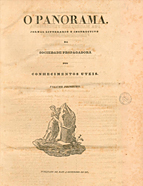

................................
Priced at $25 per issue, with options for annual, six-monthly, or quarterly subscriptions, the founders of the Society intentionally kept costs low to reach the widest possible audience—particularly the lower classes. This low-cost model, along with other defining features, was clearly inspired by the foreign press, especially the British The Penny Magazine of the Society for the Diffusion of Useful Knowledge, established in 1826. The editors openly acknowledged this influence in O Panorama , Issue 36, p. 1). In fact, the newspaper initially adopted the same format as its English counterpart: two columns and typically eight pages, with page numbers carried over consecutively in subsequent issues to encourage the creation of a complete collection. The first page featured an illustration that introduced the main article of the issue, followed by shorter articles—illustrated or not—on a variety of topics. The illustrations featured in the newspaper were, at least initially, almost exclusively of foreign origin. Wood engravings—the most effective method at the time for incorporating images into text—were an art form still scarcely practised in Portugal. Consequently, Herculano had to purchase these engravings from foreign suppliers at considerable expense ( Alexandre Herculano. Jornalista [Alexandre Herculano. Journalist], p. 42).
The success of O Panorama appears to have been immediate. Issue no. 7 included an article by Herculano titled "Galicisms," in which the editor noted that Issue 5 had achieved a print run of 5,000 copies—"a unique case in the history of periodical publications in Portugal." However, this figure was modest compared to its English inspiration, The Penny Magazine , which had a circulation of 300,000 copies in 1837 ( Alexandre Herculano jornalista , p. 26). The disparity reflects the vastly different population contexts and audiences of the two publications. These differences became evident enough that, after a year of circulation, the editors decided to adopt a new structure for the newspaper. In an annual review—following an analysis of the public's reception—Herculano introduced a revised format. First, he conducted a "diagnosis" of the Portuguese readership for such "popular" newspapers, dividing it into three categories: "The first pertains to people who only seek instruction, regardless of its form; these are few. The second class, which is the largest, consists of those who enjoy learning while being entertained. Finally, the third class is made up of those who seek only entertainment in their reading; their moral complexion is feeble and difficult to improve, but for this very reason, we must not abandon them. With the habit of reading, perhaps they will develop a love for more substantial knowledge, or at least make reading a habit, so that, in the absence of superficial material, they may sometimes turn to more instructive and profound writings" ( O Panorama , Issue 36, p. 1, 1837). This diagnosis highlighted the limitations of the Portuguese reading market, both in terms of its size and the interests of its audience. It is no surprise, therefore, that many other publishing initiatives of the time were short-lived.
This work is financed by national funds through FCT - Foundation for Science and Technology, I.P, in the scope of the projects UIDB/04311/2020 and UIDP/04311/2020.
